Sneakers

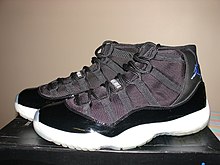
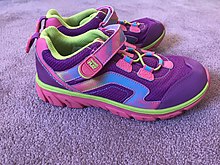
Sneakers (
Since their popularization by companies such as
Names
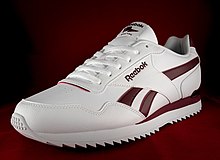
Sneakers have gone by a variety of names, depending on geography and changing over the decades. The broader category inclusive of sneakers is athletic shoes. The term 'athletic shoes' is typically used for shoes utilized for jogging or road running and indoor sports such as basketball, but tends to exclude shoes for sports played on grass such as association football and rugby football, which are generally known in North America as "cleats" and in British English as "boots" or "studs".
The word "sneaker" is often attributed to American Henry Nelson McKinney, who was an advertising agent for
The
Several terms for sneakers exist in South Africa, including gym shoes, sports shoes and takkies.[8] Other names for sneakers includes rubber shoes in Philippine English, track shoes in Singapore English, canvas shoes in Nigerian English,[dubious ] camboo ("camp boot") in Ghana English, and sportex in Greece.[clarification needed]
In Latvia any sneakers are still called botas after the Czech footwear company Botas, whose produce was one of the few foreign brands of sneakers available during the Soviet occupation.
History
This section may need to be rewritten to comply with Wikipedia's quality standards. (July 2023) |
These shoes acquired the nickname '
Plimsolls were widely worn by vacationers and also began to be worn by sportsmen on the tennis and croquet courts for their comfort. Special soles with engraved patterns to increase the surface grip of the shoe were developed, and these were ordered in bulk for the use of the British Army. Athletic shoes were increasingly used for leisure and outdoor activities at the turn of the 20th century - plimsolls were even found with the ill-fated Scott Antarctic expedition of 1911. Plimsolls were commonly worn by pupils in schools' physical education lessons in the UK from the 1950s until the early 1970s.[citation needed]
British company J.W. Foster and Sons designed and produced the first shoes designed for running in 1895; the shoes were spiked to allow for greater traction and speed. The company sold its high-quality handmade running shoes to athletes around the world, eventually receiving a contract for the manufacture of running shoes for the British team in the 1924 Summer Olympics. Harold Abrahams and Eric Liddell won the 100 m and 400 m events, kitted out with Foster's running gear.[11]
This style of footwear also became prominent in America at the turn of the 20th century, where they were called 'sneakers'. In 1892, the
During the
Adolf "Adi" Dassler began producing his own sports shoes in his mother's wash kitchen in Herzogenaurach, Bavaria, after his return from World War I, and went on to establish one of the leading athletic shoe manufacturers, Adidas.[12] He also successfully marketed his shoes to athletes at the 1936 Summer Olympics, which helped cement his good reputation. Business boomed and the Dasslers were selling 200,000 pairs of shoes each year before World War II.[13][14]
During the 1950s, leisure opportunities greatly expanded, and children and adolescents began to wear sneakers as
During the 1990s, shoe companies perfected their fashion and marketing skills. Sports endorsements with famous athletes grew larger, and marketing budgets went through the roof. Sneakers became a fashion statement and were marketed as a definition of identity and personality rather than simply athletic aids.[15]
Also during the 1990s, various vendors began producing "walking shoes" for adults using the construction technology of sneakers but visually resembling traditional leather shoes. The combination of a traditional look with increased comfort rapidly achieved wide popularity and by 2010 was displacing sales of leather shoes for adults in a parallel with the post-1950 success of sneakers among children. The shift was especially noticeable in combination with business-casual clothing.
From 1970 (five models), to 1998 (285 models), to 2012 (3,371), the number of sport shoe models in the U.S. has grown exponentially.[16]
Use in sports
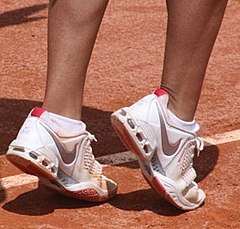
Sneakers intended for sports have a flexible sole, appropriate tread for the function, and ability to absorb impact. As the industry and designs have expanded, the term "athletic shoes" is based more on the design of the bottom of the shoe than the aesthetics of the top of the shoe. Today's designs include sandals, Mary Janes, and even elevated styles suitable for running, dancing, and jumping.
The shoes themselves are made of flexible compounds, typically featuring a sole made of dense rubber. While the original design was basic, manufacturers have since tailored athletic shoes for their specific purposes. An example of this is the spiked shoe developed for track running. Some of these shoes are made up to unusually large sizes for athletes with large feet.
Sneakers intended for running come in a range of shapes suited to different purposes. Generally, they are divided by running style: the majority are for heel-toe joggers/runners which are further subdivided into '
According to the
Notable brands
As of 2020[update], brands with global popularity include:[citation needed]
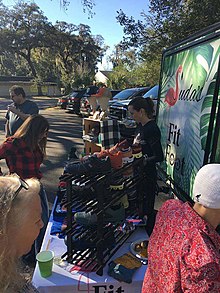
- 361 Degrees
- Adidas
- Allbirds
- Anta
- Asics
- Babolat
- Brooks
- Converse
- DC
- Diadora
- Dunlop
- Ethletic
- Feiyue
- Fila
- Hoka One One
- Hummel
- Hurley International
- Kappa
- Karhu
- K-Swiss
- Keds
- Li-Ning
- Lotto
- Merrell
- Mizuno
- New Balance
- Nike
- On
- Onitsuka Tiger
- PF Flyers
- Pony
- Pro-Keds
- Puma
- Reebok
- Salomon
- Saucony
- Skechers
- Stride Rite
- Supra
- Tisza Cipő
- Umbro
- Under Armour
- Vans
- World Balance
- Xtep
Culture

Sneakers have been an important part of
Sustainability
Contemporary sneakers are largely made from synthetic materials, and the materials and manufacturing process produce, on average, about 14 kg (31 lb) of
See also
References
- ^ Footwear, World. "Global Footwear Industry: Positive Dynamics in 2018". World Footwear. Retrieved 2020-07-30.
- ^ Mental Floss magazine, Sept-Oct 2008
- ISBN 9781341245022.
- ISBN 978-0544703391. Retrieved 13 July 2017.
- ^ Hickey, Walter (5 June 2013). "22 Maps That Show How Americans Speak English Totally Differently From One Another". Business Insider. Retrieved 2017-03-09.
- ^ "The modern guide to Aussie slang | Study in Australia".
- ^ "Geordie Dictionary". www.englandsnortheast.co.uk. Retrieved 2017-03-09.
- ISBN 1515051226.
- ^ "History of Sneakers". Archived from the original on 2016-08-20. Retrieved 2023-10-06.
- ISBN 9781409061953.
- ^ Foster, Rachael. "Foster's Famous Shoes". Bolton Revisited. Retrieved 15 October 2015.
- ISBN 978-0-06-124658-6.
- ^ "Exploring the History of Basketball Shoes". Sports Domain Lab. 18 March 2019.
- ^ "How Adidas and PUMA were born". in.rediff.com. 8 November 2005. Retrieved 26 September 2010.
- ^ Pribut, Stephen M. "A Sneaker Odyssey" Archived 2020-07-28 at the Wayback Machine. Dr. Stephen M. Pribut's Sport Pages. 2002. Web. 23 June 2010.
- ^ Aichner, T. and Coletti, P. 2013. "Customers' online shopping preferences in mass customization". Journal of Direct, Data and Digital Marketing Practice, 15(1): 20-35.
- ^ "Understand pronation to get the correct running shoes". Comfort Hacks. 11 September 2015. Retrieved 14 October 2015.
- PMID 35993829..
- ^ Chesto, Jon (2017-07-19). "New City Sports owners plot revival of Boston brand". The Boston Globe. Archived from the original on 2017-07-21. Retrieved 2017-07-20.
- ^ Belzer, Jason. "Sneaker Wars: Kanye West Signs Deal with Adidas, Drake with Jordan Brand". Forbes. Retrieved 2016-01-28.
- ^ 2014 Saks Fifth Avenue catalog
- ISSN 0959-6526.
- ^ a b "Are Eco-Runners The Next 'It' Trainer?". British Vogue. 21 October 2019. Retrieved 2021-02-19.
- ^ Hoskins, Tansy E. (2020-03-21). "'Some soles last 1,000 years in landfill': the truth about the sneaker mountain". The Guardian. Retrieved 2021-02-19.
External links
- Segesser, B.; Pförringer, Wolfgang; Pförringer, W. (1989). The Shoe in Sport. Year Book Medical Publishers. ISBN 9780815178149.
 Media related to Sneakers (footwear) at Wikimedia Commons
Media related to Sneakers (footwear) at Wikimedia Commons
